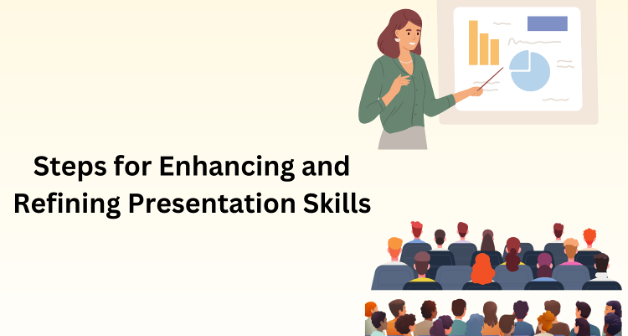The key to success of professional communication is having strong presentation abilities. Many different sectors respect the ability to successfully communicate ideas, captivate an audience, and leave a lasting impression.
The first step to both personal and professional development is realising the importance of Presentation Skills and learning how to enhance them. This blog will examine How to Improve Presentation Skills, offering readers a road map for becoming self-assured and captivating speakers.
Table Of Contents
- Understanding the Importance of Presentation Skills
- Steps for Enhancing and Refining Presentation Skills
- Conclusion
Understanding the Importance of Presentation Skills
Let’s understand the importance of presentation skills in the workplace before discussing the improvement steps. Possessing strong presentation abilities helps with:
Clear Communication
People with strong presentation abilities can convey concepts in a clear, succinct manner, which helps the audience understand what is being said.
Professional Credibility
Confident presentation skills contribute to increased professional credibility. To promote confidence and trust, it is advised to use a well-delivered presentation when speaking to stakeholders, clients, or coworkers.
Career Advancement
People with strong presentation abilities are frequently able to advance in their careers. Persuasive speakers have a higher chance of sticking out in competitive settings.
Audience Engagement
Audience Engagement is the heart for a presentation to be successful. Presenting information effectively captures the attention of the audience, encouraging engagement and a favourable reaction to the information.
Influential Leadership
Presenters who are at the top of their game are better able to motivate and inspire others. Effective leadership is around the capacity to communicate a captivating vision, whether speaking to a group of people.
Steps for Enhancing and Refining Presentation Skills
Self-Assessment
Start by evaluating your existing presentation abilities. Consider previous presentations, noting your advantages and disadvantages. To acquire insightful information, think about asking mentors or coworkers for their opinions.
Set Clear Objectives
Establish specific goals for every presentation. Recognise the goals, main points, and intended results. An agenda that is clear and concise helps you stay on course and directs your presentation’s structure.
Audience Analysis
Analyse your audience and adjust your presentation accordingly. Examine their interests, knowledge, and expectations. Engagement and connection are increased when you modify your content and distribution method to fit your target.
Effective Storytelling
To make your presentation more memorable and relatable, use storytelling tactics. Anecdotes and real-world examples help humanise your material and build a stronger emotional bond with your audience.
Body Language Mastery
The art of mastering body language is important since it is a key component of efficient communication. Retain eye contact, make deliberate movements, and pay attention to your posture. A self-assured physical presence amplifies your total impression.
Voice Modulation
Develop your modulation skills to keep the audience engaged, emphasise important points, and communicate excitement. To make your speech more dynamic, try changing the pitch, tone, and tempo of your delivery.
Utilize Visual Aids Wisely
Slides and other visual aids, such as graphics, should enhance your content, not take centre stage. Keep images eye-catching, uncomplicated, and clear. To guarantee a smooth transition into your presentation, practise using your slides.
Interactive Elements
Use interactive components to actively involve your audience. This could involve queries, guiding conversations, or utilising surveys and polls. An event becomes more memorable and interactive when there is interaction.
Handle Nervousness Effectively
When it comes to public speaking, nervousness is a typical difficulty. Learn how to successfully handle anxious energy rather than attempting to completely eradicate it. Anxiety can be reduced by using strategies like visualisation, controlled breathing, and encouraging self-talk.
Continuous Learning
To improve your abilities, take part in webinars, workshops, or a course on presentation techniques. You can improve continuously by being exposed to new methods, best practices, and constructive criticism through continuous learning.
Record and Review
Make sure to record your presentations and give them an unbiased critique. This enables you to pinpoint areas where your body language, delivery, and material organisation need to be improved. Additionally, it fosters self-awareness.
Seek helpful feedback
Make a conscious effort to get criticism from mentors, friends, or coworkers. Beneficial insights and diverse viewpoints are provided by constructive criticism, which supports focused improvement.
Practice Regularly
The key to progress is practice. Practise your presentations several times to gain confidence, polish your delivery, and make sure that the transitions between the main topics flow naturally.
Join Speaking groups
If you’d want to practise in a supportive setting, you might want to consider joining Toastmasters or Speaking clubs. These organisations offer a forum for improving presentation abilities, getting criticism, and picking up tips from colleagues.
Embrace Technology
Look into technological resources that can improve your presentations. This could involve cutting-edge presentation software, virtual reality, or interactive elements. Keeping up with technological developments can give your delivery a more contemporary feel.
Conclusion
Improving and perfecting presentation skills requires ongoing learning and self-improvement. These doable actions can help people build their confidence, effectively engage audiences, and improve their overall presentation skills. Developing oneself as a presenter and analysing your audience, as well as learning body language and accepting lifelong learning, are all important steps towards being a more captivating and influential speaker. People may realise the full potential of their presentation abilities and leave a lasting impression in both professional and social contexts with commitment, practice, and progress.




